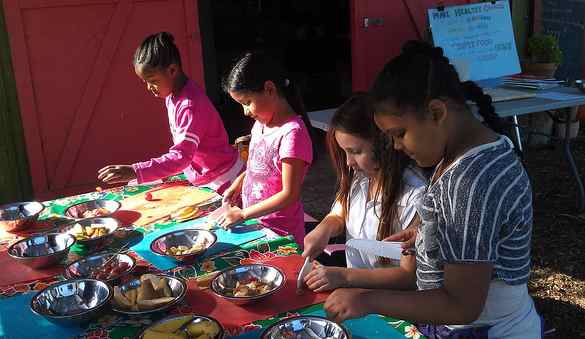Like most inner-city garden stories, this one begins with a neglected lot: the rundown playground at 24th Street Elementary, a Title I school in the West Adams neighborhood of Los Angeles. In 2003, city bond funds were allocated to repave the lot, but a second-grade teacher and the school’s principal had a different idea. Soliciting help from the local community, garden clubs, and the Los Angeles Police Department, they laid the groundwork for a green space they hoped might eventually include teaching gardens, playing fields, and picnic areas. Two years later, after the pavement was gone, 2,000 teachers, students, parents, and community members spent a day installing a test garden. It was a hit: teachers immediately began integrating the garden into their lessons, as well as using it as a place to let their students connect with nature and blow off steam. Today that acre includes a 55-tree fruit orchard, 16 vegetable beds, shaded teaching areas, and a variety of native gardens.
Garden School Foundation (GSF) was formed to manage aspects of the transformative project, providing community volunteers and establishing grade-specific plans that bring to life classroom lessons on food chains, photosynthesis, ecosystems, and global health. More recently, GSF helped establish neighboring Widney High School’s Horticulture Vocational Program. Students, who have various physical and developmental disabilities, are learning the art of plant propagation in preparation for jobs at farmers markets and urban agriculture organizations.
At 24th Street School, families—usually 30 to 50 of them on a given day—spend one Saturday each month working in the garden. It’s an essential part of keeping the garden healthy, and during the final hour there’s a workshop, either to use the solar oven or bicycle blender in preparing a recipe with items harvested from the garden or to take in a demonstration on, for example, how to compost. Families are invited to bring home any leftovers. GSF Executive Director, Julia Cotts, says workdays are an important opportunity for students to show their families what they’ve done.
“There are some kids for whom this is the best thing ever,” she says, noting that she overheard one young boy say, “this is the most fun I’ve ever had in my life,” as he pulled weeds.
24th Street doesn’t have the only school garden in L.A., and when word spread about GSF’s approach, other Title I schools with neglected gardens reached out for tips on how they might resurrect those weedy patches for the physical and academic benefit of their own students.
“The question was: How do we train teachers to find moments throughout the year when they can easily bring their kids out to the garden to expand on what’s being taught in the classroom and also get kids out there harvesting, preparing, and eating fresh, delicious produce and get them more excited about eating vegetables?” says Cotts. The answer was the Seed to Table program, 20 hour-long lessons for each of the six elementary grades that are aligned with state and national standards and have at their core the garden. To date, five L.A. County elementary schools are using the program, which GSF is preparing to make available nationwide within the year. In addition to complete lessons with activities, Seed to Table offers planting guidelines and a trained garden coordinator for each school, though that will not be a component of the national program. The coordinator assists in the presentation of lessons, solicits donations from businesses, coordinates volunteers and parent support, and leads afterschool activities. Schools apply to take part in the program, and, at a minimum, must have a parent and an administrator on board—in addition to a garden.
GSF is excited about sharing the Seed to Table program with schools around the country.
“The more kids we can get outside learning—especially kids who are living in an asphalt jungle and spend very little time in nature—we’ll keep trying to meet that need however we can,” says Cotts.













